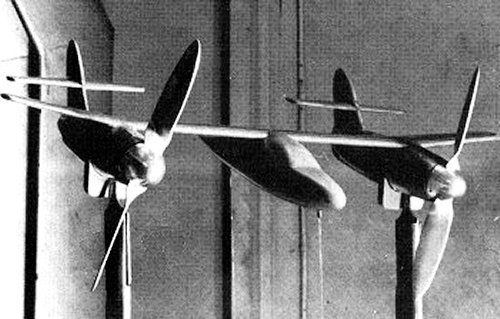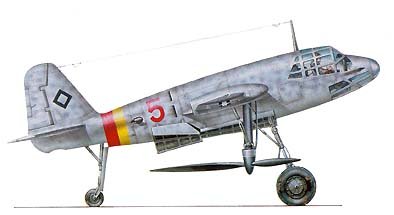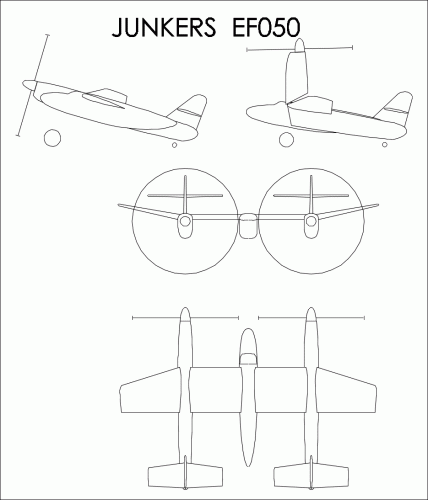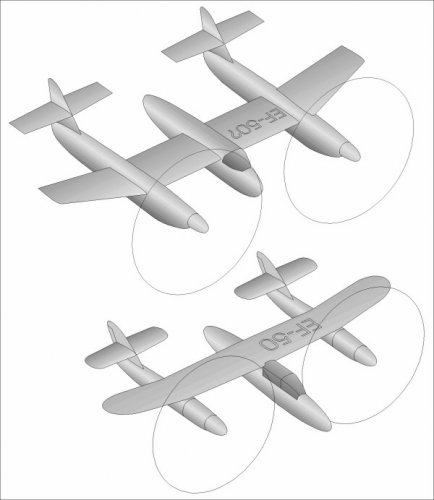You are using an out of date browser. It may not display this or other websites correctly.
You should upgrade or use an alternative browser.
You should upgrade or use an alternative browser.
Junkers EF 50
- Thread starter hesham
- Start date
- Joined
- 11 March 2006
- Messages
- 8,625
- Reaction score
- 3,808
In "Hugo Junkers. Pionier der Luftfahrt - seine Flugzeuge" the EF 50 is described as
racing or record aircraft, without mention of a VTOL capability. Of course, the very
large props would make a very long landing gear necessary, that probably would result
in a steep angle while standing on the ground, which could give a STOL capability.
racing or record aircraft, without mention of a VTOL capability. Of course, the very
large props would make a very long landing gear necessary, that probably would result
in a steep angle while standing on the ground, which could give a STOL capability.
- Joined
- 25 July 2007
- Messages
- 4,299
- Reaction score
- 4,198
Jemiba said:In "Hugo Junkers. Pionier der Luftfahrt - seine Flugzeuge" the EF 50 is described as
racing or record aircraft, without mention of a VTOL capability. Of course, the very
large props would make a very long landing gear necessary, that probably would result
in a steep angle while standing on the ground, which could give a STOL capability.
Horst Zöller described the EF 050 as a "VTOL aircraft as Fa269" on LWAG. Elsewhere (sorry, I forget where), it was described as a "convertiplane". Odd arrangement if it was to be a VTOL aircraft.
- Joined
- 11 March 2006
- Messages
- 8,625
- Reaction score
- 3,808
Sorry, in the mentioned book it is described as "perhaps racing/ record aircraft",
had overlooked this. If it was in fact a VTOl design it could have had tiltable props,
similar to the Dorand design, that can be found here http://modelarchives.free.fr/Bestiaire/DVTOL_P/index.html,
or maybe as the "Potez 63 VTOL" (http://modelarchives.free.fr/Bestiaire/P63VTOL_P/index.html),
which seems to have been an attempt for an ultra-STOL aircraft.
had overlooked this. If it was in fact a VTOl design it could have had tiltable props,
similar to the Dorand design, that can be found here http://modelarchives.free.fr/Bestiaire/DVTOL_P/index.html,
or maybe as the "Potez 63 VTOL" (http://modelarchives.free.fr/Bestiaire/P63VTOL_P/index.html),
which seems to have been an attempt for an ultra-STOL aircraft.
- Joined
- 28 October 2006
- Messages
- 1,004
- Reaction score
- 118
Another interesting thread.
On the Ef50, as pointed out by Jemiba, with such huge props, what would the landing gear have been like?
I imagine the legs would have been like stilts. And how do you stow such 'Daddy Long' legs?
Cheers
P
On the Ef50, as pointed out by Jemiba, with such huge props, what would the landing gear have been like?
I imagine the legs would have been like stilts. And how do you stow such 'Daddy Long' legs?
Cheers
P
- Joined
- 11 March 2006
- Messages
- 8,625
- Reaction score
- 3,808
Hard to tell, if it would have been an ultra-STOL with props fixed, I think,
the legs wouldn't have been too long and the nacelles would have given
plenty of room for stowing them.
As a VTOL the props had to be brought in a position above the wing to get the
thrustline right in a line with the CG. Looking at the model, I noticed that it
was attached with a kind of blocks under the nacelles, different to the attachment,
that can be seen on other photos of such models. Maybe this was done in pre-
paration for test to tilt the nacelles. Another point is, that the model has props,
not to be found on all wind tunnel models.
the legs wouldn't have been too long and the nacelles would have given
plenty of room for stowing them.
As a VTOL the props had to be brought in a position above the wing to get the
thrustline right in a line with the CG. Looking at the model, I noticed that it
was attached with a kind of blocks under the nacelles, different to the attachment,
that can be seen on other photos of such models. Maybe this was done in pre-
paration for test to tilt the nacelles. Another point is, that the model has props,
not to be found on all wind tunnel models.
Attachments
Tophe
ACCESS: Top Secret
Thanks Jemiba. Is this your personal interpretation or an unknown source? (Both would be wonderful)
- Joined
- 11 March 2006
- Messages
- 8,625
- Reaction score
- 3,808
it's just my interpretation of the photo. The side view with the tilted nacelles
should show, what a VTOL version could have look like.
Sorry, didn't realise at all, that it really is a twin boom aircraft !
should show, what a VTOL version could have look like.
Sorry, didn't realise at all, that it really is a twin boom aircraft !
Vietcong
Avation Enthusiast from VN
How about the Junker Ju EF 112 and Ju 635
:-\
:-\
Tophe
ACCESS: Top Secret
Yes, I am going to update my EF-50 drawing and I will post a view of them three, thanks.
Jemiba said:Another point is, that the model has props,
not to be found on all wind tunnel models.
Note as well that the props seem to be low-speed props, adding to the STOL/VTOL possibility.
archipeppe
ACCESS: Top Secret
- Joined
- 18 October 2007
- Messages
- 2,433
- Reaction score
- 3,160
It's clear that Junkers designers was heavily impressed by the SIAI S-55 configuration.
Tophe
ACCESS: Top Secret
- Joined
- 11 March 2006
- Messages
- 8,625
- Reaction score
- 3,808
The text says, that in his private aerodynamical institute in Aachen, Hugo Junkers madee systematic experiments to
determine the principles for the construction of full metal construction aircraft with cantilever wings. Starting with simple
bodies (you can see a number on the photo under the one you posted), those tests led to aircraft like the Junkers J 3 and
later F 13. The twin fuselage model isn't mentioned explicitly, but I think, it's just an aerodynamic test object (note the
thickened wing/fuselage junctions), not a project on its own.
determine the principles for the construction of full metal construction aircraft with cantilever wings. Starting with simple
bodies (you can see a number on the photo under the one you posted), those tests led to aircraft like the Junkers J 3 and
later F 13. The twin fuselage model isn't mentioned explicitly, but I think, it's just an aerodynamic test object (note the
thickened wing/fuselage junctions), not a project on its own.
Similar threads
-
-
Junkers Ju 85/88/188/388 & 488 - Projects, Prototypes and Variants
- Started by hesham
- Replies: 93
-
Junkers EF 127.02 (February 1945)
- Started by Justo Miranda
- Replies: 1
-
Junkers EF 127.01 Wally (December 16, 1944)
- Started by Justo Miranda
- Replies: 0
-




